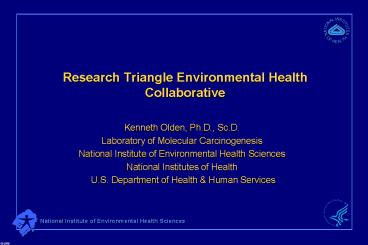Research Triangle Environmental Health Collaborative - PowerPoint PPT Presentation
1 / 20
Title:
Research Triangle Environmental Health Collaborative
Description:
National Institute of ... National Institute of Environmental Health Sciences. Environmental ... National Institute of Environmental Health ... – PowerPoint PPT presentation
Number of Views:49
Avg rating:3.0/5.0
Title: Research Triangle Environmental Health Collaborative
1
Research Triangle Environmental Health
Collaborative
- Kenneth Olden, Ph.D., Sc.D.
- Laboratory of Molecular Carcinogenesis
- National Institute of Environmental Health
Sciences - National Institutes of Health
- U.S. Department of Health Human Services
2
Intrinsic Genetic Susceptibility
Environmental Exposures
Human Health/Disease
Behavior/Age/Stage of Development
3
Genetics Loads the Gun, but Environment Pulls
the Trigger
Judith SternProfessor of Nutrition and Internal
MedicineUniversity of California at Davis
4
ENVIRONMENT includes
- Industrial chemicals
- Agricultural chemicals
- Physical agents (e.g., heat,
radiation) - By-products of combustion and industrial
processes (e. g. dioxin)
- Foods and nutrients
- Prescription drugs
- Lifestyle choices and substance abuse
- Social and economic factors
- Biological agents
5
Studies are now being reported that blow away
the myth that bad genes are responsible for the
majority of human morbidity and mortality.
- Cancer about 2/3 is non-genetic (NEJM
343(2)78-85, 2000 - Lichtenstein, et al Int J Cancer 83743-749,
1999 Verkasalo et al) - Parkinsons Disease about 85 is non-genetic
(JAMA 281(4) - 341-346, 1999 Tanner, et al)
- Cardiovascular Disease about 90 of patients
with heart - disease have at least one or more of the
major risk factors - (JAMA, Aug 20, 2003 Greenland et al)
- Autoimmune Diseases about 2/3 is non-genetic
(EHP 107 - 667-672, 1999 Bishop et al)
6
Genes are only a small part of our make-up the
environment has a spectacular impact.
Eric LanderDirector, MIT Center forGenome
ResearchWashington FAX9/25/2001
7
- M E D I C I N E
- Stop Blaming Your Genes
- A new study shows that environment matters more
- than genetics in determining whether
you get cancer - By Sharon Begley
- Newsweek, 7/24/2000, p.53
8
(No Transcript)
9
(No Transcript)
10
Two of the big challenges we face as a nation are
- Developing a better understanding of how gene and
environmental agents interact in human health and
disease. - Translating environmental genomic information and
technology into practice to prevent disease.
11
- Success is almost always a collaborative
enterprisebringing people together to solve
complex problems. - By creating the Research Triangle Environmental
Health Collaborative, we want to promote RTP
institutions as the leaders in environmental
health. - Promote RTP as the epicenter for environmental
health research, environmental policy and
development of environmental technology.
12
- Research Triangle Park is a reality today because
of the shared vision of local governments,
business and academic leaders. - Organizations that were able to set aside narrow
self-interests to promote a broader goal.
13
- The collaborative vision and leadership of the
RTP CEOs created the economic engine that reduced
unemployment, increased the tax base, increased
the quality and visibility of our academic
institutions, and changed the social fabric of
the Research Triangle community.
14
- Many of the challenges that we face as a
community, as a Nation, cannot be solved without
partners, without collaboration.
15
The Research Triangle Environmental Health
Collaborative
- Primary Objective To create a forum to promote
partnerships between government (local and
national), academia, public interest groups, and
business with respect to research priority
setting and public policy.
16
Founding members of the Research Triangle
Environmental Collaborative (a non-profit 501C3
organization)
- William Greenlee, Ph.D., The Hamner Institutes
for Health Science - David Hinton, Ph.D., Duke University, School of
the Environment - Ernest Hodgson, Ph.D., North Carolina State
University - Rich Cohn, Ph.D., Constella Group
- Edward Baker, M.D., University of North Carolina,
School of Public Health - Kenneth Olden, Ph.D., National Institute of
Environmental Health Sciences - With support and input from Don Holzworth,
Constella, and Larry Reiter, EPA
17
Primary Activities
- To organize a major summit to identify the grand
challenges in environmental health. - To organize working groups to develop the
necessary activities (e.g., communication
vehicle) to achieve the proposed grand
challenges. - To develop a fund raising effort to sustain the
needed activities. - To solicit and welcome new members.
18
Practical benefits to be derived from the work of
the Research Triangle Environmental Health
Collaborative
- Enhance visibility of RTP and various
participants. - Provide a neutral forum for discussion of
important, but potentially divisive environmental
health issues. - Provide expert advice and review.
- Foster economic growth and development (business
start-ups, job creation). - Expand the areas talent and expertise in
environmental health. - Leverage local resources.
19
Conclusion
- Human progress is inherently a cooperative
enterprise. - While each cell in the human body has its own
identity, its own mission, individual cells
function in concert with trillions of other cells
as apart of a complex and highly successful
organism. - By working together, we too can achieve
extraordinary success as a community.
20
- For more information contact
- David P. Brown at dabrown_at_constellagroup.com
or - 919-313-7710































